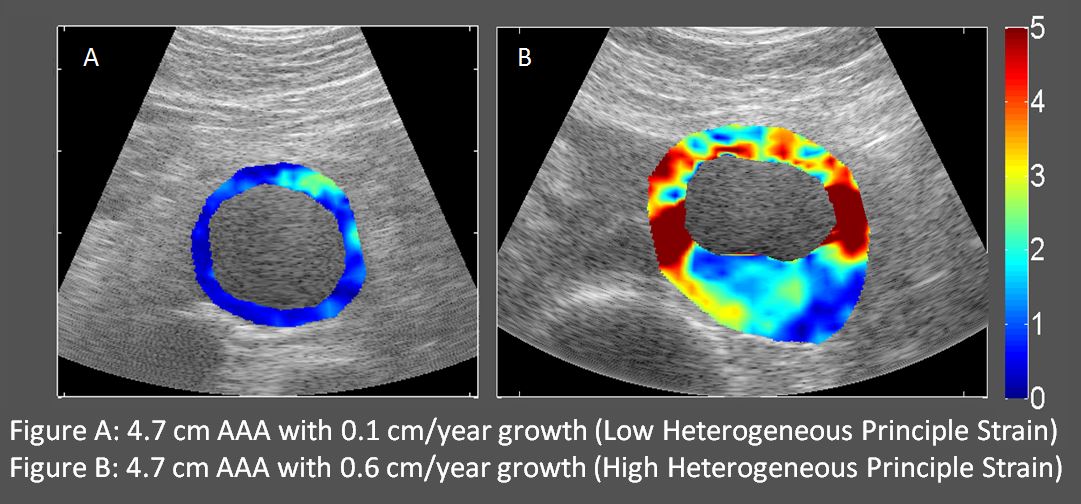Back to 2016 Annual Symposium Abstacts
Heterogeneous Wall Strain is Associated with Increased Abdominal Aortic Aneurysm Growth Rate
Doran S. Mix, MD, Lauren Trakimas, DO, Michael C. Stoner, MD, Jennifer L. Ellis, MD, Adam J. Doyle, MD, Roan J. Glocker, MD, Michael Richards, PHD.
University of Rochester Medical Center, Rochester, NY, USA.
OBJECTIVES:
Aneurysmal growth is considered part of the natural history of abdominal aortic aneurysmal (AAA) disease but no screening metric exist that can predict future growth. We propose that heterogeneous ultrasound derived aortic wall strain can be used as a predictor of accelerated aneurysmal growth.
METHODS:
High speed (>50 fps) raw digital RF cine loops were obtained during patient’s scheduled monitoring or screening visits for AAA disease. A two-dimensional finite element mesh was defined for the entire image to allow for image reregistration, using a non-linear optimization technique, and calculation of regional strain throughout the image. Strain was simultaneously calculated across an entire cardiac cycle. Maximum principle strain was calculated for both the aortic vessel wall and thrombus at the anterior, posterior, lateral, and medial locations of the aneurysm. Strain difference was calculated as the difference in maximal principle strain between the aortic wall segments.
RESULTS:
Ultrasound data was collected and processed for 40 patients (mean age 71.9±1.38 years, 75% male) with AAA. The average maximal diameter was 4.26±1.28 cm. Comorbidities included hypertension (85%), diabetes mellitus (30%), atrial fibrillation (21%), and an average 33 pack-year smoking history. An average of 1.85±0.95% maximal principle strain was detected with an average maximal principle strain difference of 1.42±1.48%. Large aneurysms (> 5cm) had an average maximal principle strain of 1.49±0.28% vs. 1.91±1.05% (p = 0.15) and a maximal principle strain difference of 1.42±1.59% vs 1.47±1.21% (p = 0.9). A total of 33 patients had previous measurements of their aneurysms with a mean follow-up of 12 months and an average growth of 0.25±0.07cm. In patients with rapid growth ( > 0.4 cm/year), greater a maximal principle strain 2.56±1.82% vs. 1.61±0.55% (p=0.07) and a maximal principle strain difference 2.33±2.30% vs 0.95±0.60% (p=0.02) was detected.
CONCLUSIONS:
Maximal principle strain difference is significantly greater in patients with rapid aneurysmal growth independent of aneurysmal size and can be used as an initial screening tool for patients who require more frequent screening intervals. Future work in ultrasound derived regional strain analysis can help to elucidate the interplay between aortic wall mechanics and aortic wall biology.

Back to 2016 Annual Symposium Abstacts
|






